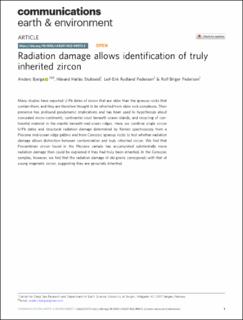| dc.contributor.author | Bjerga, Anders | |
| dc.contributor.author | Stubseid, Håvard Hallås | |
| dc.contributor.author | Pedersen, Leif-Erik Rydland | |
| dc.contributor.author | Pedersen, Rolf B. | |
| dc.date.accessioned | 2022-06-09T11:30:17Z | |
| dc.date.available | 2022-06-09T11:30:17Z | |
| dc.date.created | 2022-02-24T11:05:01Z | |
| dc.date.issued | 2022 | |
| dc.identifier.issn | 2662-4435 | |
| dc.identifier.uri | https://hdl.handle.net/11250/2998129 | |
| dc.description.abstract | Many studies have reported U-Pb dates of zircon that are older than the igneous rocks that contain them, and they are therefore thought to be inherited from older rock complexes. Their presence has profound geodynamic implications and has been used to hypothesize about concealed micro-continents, continental crust beneath ocean islands, and recycling of continental material in the mantle beneath mid-ocean ridges. Here, we combine single zircon U-Pb dates and structural radiation damage determined by Raman spectroscopy from a Pliocene mid-ocean ridge gabbro and from Cenozoic igneous rocks to test whether radiation damage allows distinction between contamination and truly inherited zircon. We find that Precambrian zircon found in the Pliocene sample has accumulated substantially more radiation damage than could be explained if they had truly been inherited. In the Cenozoic samples, however, we find that the radiation damage of old grains corresponds with that of young magmatic zircon, suggesting they are genuinely inherited. | en_US |
| dc.language.iso | eng | en_US |
| dc.publisher | Nature | en_US |
| dc.rights | Navngivelse 4.0 Internasjonal | * |
| dc.rights.uri | http://creativecommons.org/licenses/by/4.0/deed.no | * |
| dc.title | Radiation damage allows identification of truly inherited zircon | en_US |
| dc.type | Journal article | en_US |
| dc.type | Peer reviewed | en_US |
| dc.description.version | publishedVersion | en_US |
| dc.rights.holder | Copyright 2022 The Author(s) | en_US |
| dc.source.articlenumber | 37 | en_US |
| cristin.ispublished | true | |
| cristin.fulltext | original | |
| cristin.qualitycode | 1 | |
| dc.identifier.doi | 10.1038/s43247-022-00372-2 | |
| dc.identifier.cristin | 2005089 | |
| dc.source.journal | Communications Earth & Environment | en_US |
| dc.identifier.citation | Communications Earth & Environment. 2022, 3, 37. | en_US |
| dc.source.volume | 3 | en_US |

